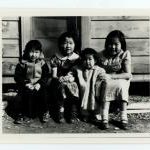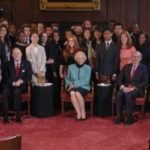This activity presents students with a 1937 letter written by newspaper publisher Frank Gannett opposing President Franklin Delano Roosevelt’s plan to “reorganize the judiciary” (also known as his “court-packing” plan). Students will read and analyze this letter to understand Gannett’s perspective on this controversial issue.
The Second Amendment
Why do we have a right to bear arms? How has that right changed? This video lecture is part of an online course called “Introduction to Key Constitutional Concepts and Supreme Court Cases,” taught by University of Pennsylvania law professor Kermit Roosevelt III. The course explores the questions: Where does the Constitution come from? How has it changed over the years? How do we know what it means?
Presidential Inaugurations, Past and Present
Every four years, on the steps of the U.S. Capitol building, the newly-elected President of the United States is inaugurated. This event not only includes the president taking the oath of office, but also provides the opportunity for the new President to lay out the direction he hopes to take the country. By analyzing historic texts and visuals, students can find common themes as well as important differences when comparing different inaugurations.
The American Presidency: Core Documents
This collection of documents on the presidency begins with Alexander Hamilton’s commentary on the sections of the Constitution related to the executive branch and ends with President Barack Obama’s address to the nation defending his interpretation of executive authority under the Constitution to use force against the Syrian regime. The documents cover the executive’s role and the specific topics of presidential selection, term limits, and impeachment.
Documents and Debates in American History and Government – Vol. 2, 1865-2009
The Core Documents Collection – Documents and Debates is structured around a series of topics, each based on a question for debate. For each topic, there is a collection of documents that, together, form the basis of argument over that topic – from those who debated it at a given point in American history. Volume One covers 1865-2009.
The goal is to explore a series of critical moments in American history by asking questions for which there are not simple yes/no answers, but instead call for informed discussion and rational debate. The Documents and Debates readers also include appendices of additional documents, and together are a perfect fit for any American History survey course, including AP U.S. History.
Japanese American Internment

On February 19, 1942, President Franklin D. Roosevelt issued Executive Order 9066, which gave the military broad powers to ban any citizen from a coastal area stretching from Washington state to California and extending inland into southern Arizona. For the next four years, more than 120,000 persons of Japanese ancestry—77,000 of them American citizens—were removed from this area and incarcerated indefinitely without criminal charges or trial. Forty-six years and eight presidents later, on August 10, 1988, President Ronald Reagan signed the Civil Liberties Act of 1988 into law.
Equal Protection: What Is Discrimination?
What is the purpose of the equal protection clause? What did Plessy v. Ferguson and Brown v. Board of Education say? What are two ways of understanding the clause? This video lecture is part of an online course taught by University of Pennsylvania law professor Kermit Roosevelt III. “Introduction to Key Constitutional Concepts and Supreme Court Cases” covers the topics: Where does the Constitution come from? How has it changed over the years? How do we know what it means?
A Conversation on the Importance of the Japanese Internment Cases

Justices Stephen G. Breyer, Sandra Day O’Connor and Anthony M. Kennedy discuss two landmark cases, Korematsu v. U.S. and Hirabayashi v. U.S., in which the Supreme Court tried to strike a balance between individual rights and national security during wartime. The cases stem from President Franklin Roosevelt’s 1942 executive order that mandated the relocation of Japanese and Japanese Americans to internment camps. This video complements the documentary Korematsu and Civil Liberties.
The Reconstruction Amendments
How did the Constitution change during Reconstruction? This video lecture is part of a an online course called “Introduction to Key Constitutional Concepts and Supreme Court Cases,” taught by University of Pennsylvania law professor Kermit Roosevelt III. The course explores these questions: Where does the Constitution come from? How has it changed over the years? How do we know what it means?
The Civil War and Reconstruction
Why was the Civil War fought? How did Reconstruction change the relationship between the federal government, the states and the people? This video lecture explores these questions. It’s part of an online course taught by University of Pennsylvania law professor Kermit Roosevelt III. “Introduction to Key Constitutional Concepts and Supreme Court Cases” covers the topics: Where does the Constitution come from? How has it changed over the years? How do we know what it means?